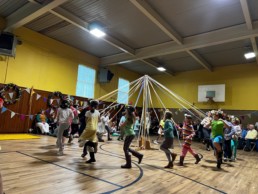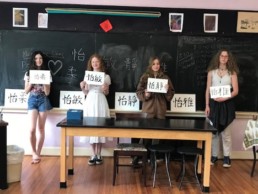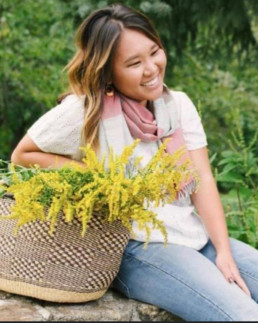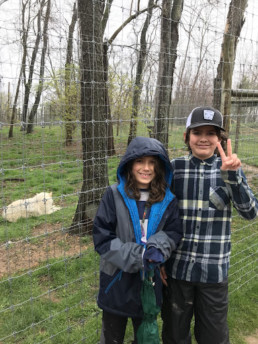May Day + 35th Anniversary Celebrations!
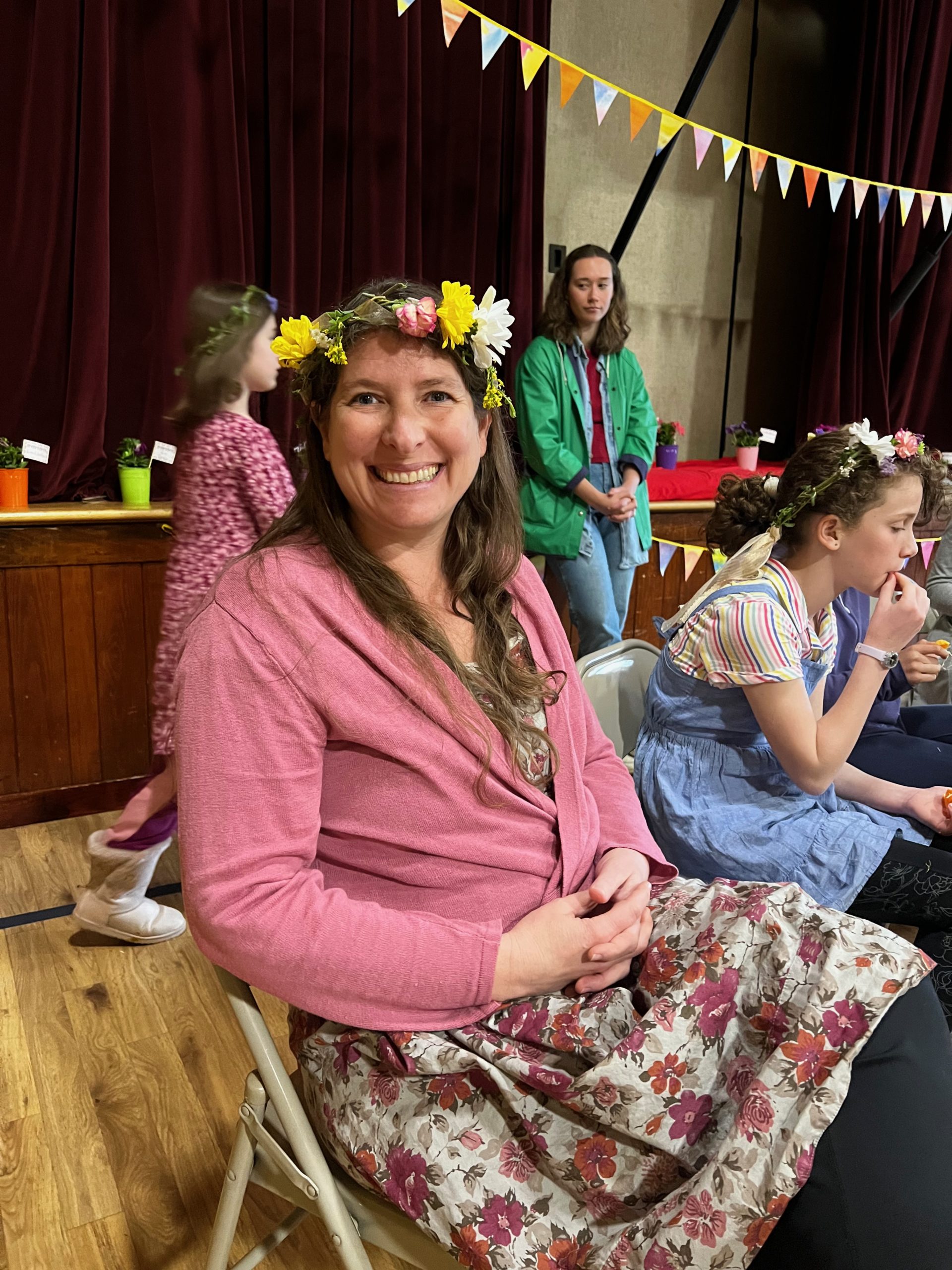

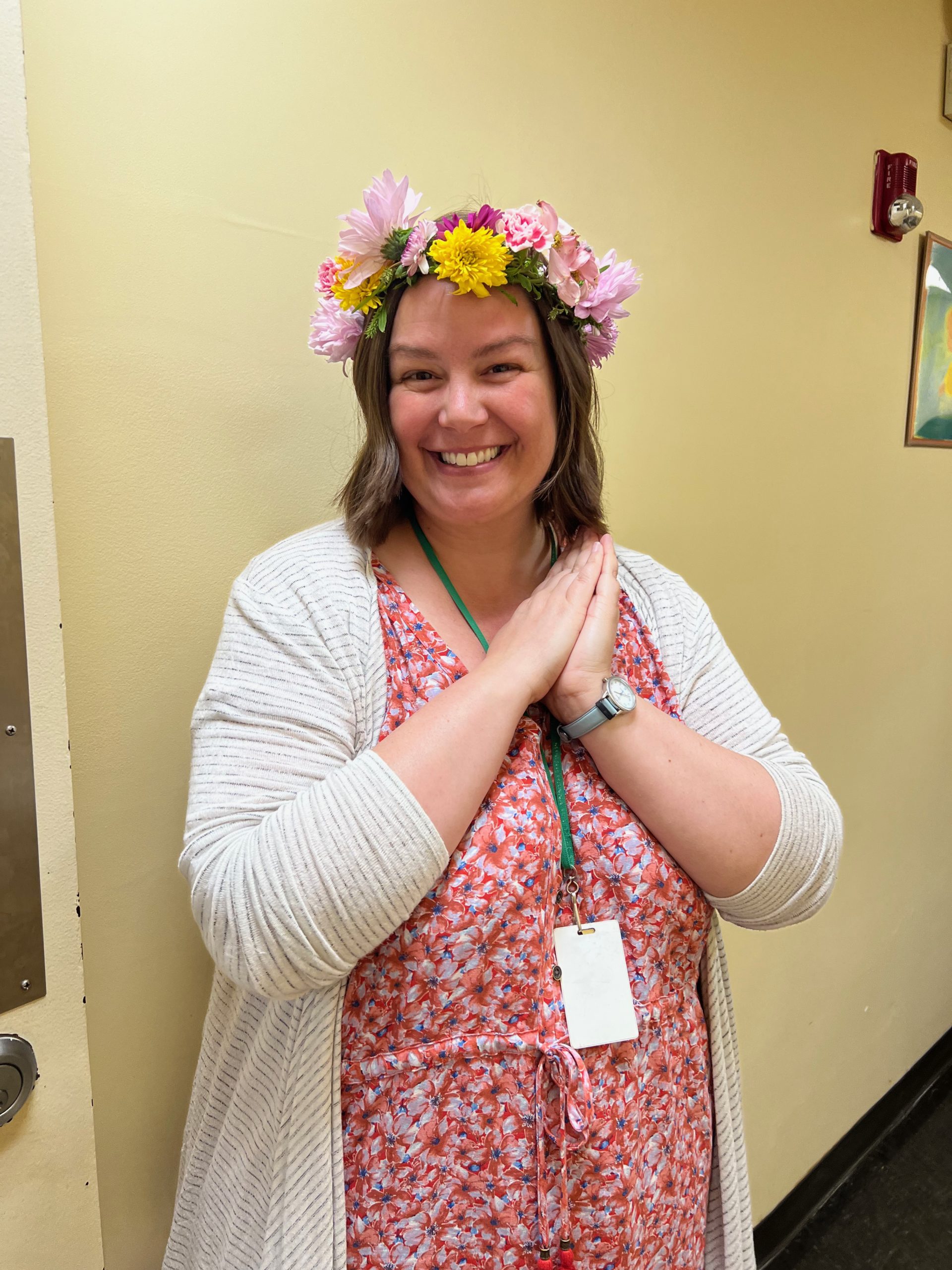
We had an eventful and joyous day on Friday, May 6th as we celebrated our annual May Day festival and our 35th anniversary! We hoped for a bright and sunny day for our students to dance around the Maypole and for our whole community to come together to celebrate. Mother Nature had other plans, though. It may have been raining outside but our gymnasium was filled with wonder and delight.
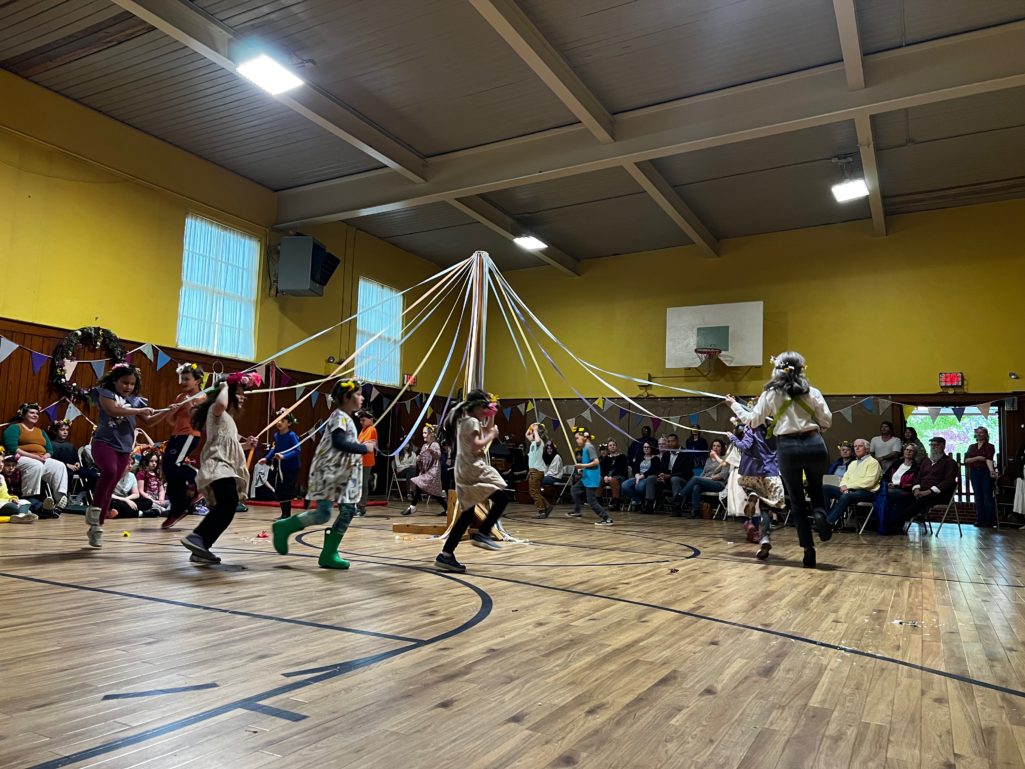
Honoring the rhythms and cycles of nature are a core part of Waldorf education. May Day, which lands about halfway between the Spring Equinox and the Summer Solstice, is a festival our students look forward to all year. They spend weeks learning their May Day songs and dances with our Music and Chorus teacher, Nina Radanovic. Kindergarteners begin the day by delivering small bouquets of fresh flowers to our school neighbors. Parents arrive in the morning to decorate the school and bring flowers to the classes. The students spend the morning creating their May Crowns which they proudly wear all day.
The student procession begins with the 8th grade students walking to collect the first graders, then second graders, and so on. The student procession enters the gym, where their families and loved ones are waiting, and the festivities begin! This year, our 6th graders opened the festival with the North Skeleton Sword Dance and 8th graders followed with the Upton-upon-Severn stick dance as 7th graders played music, led by Orchestra teacher, Michael Cameron.
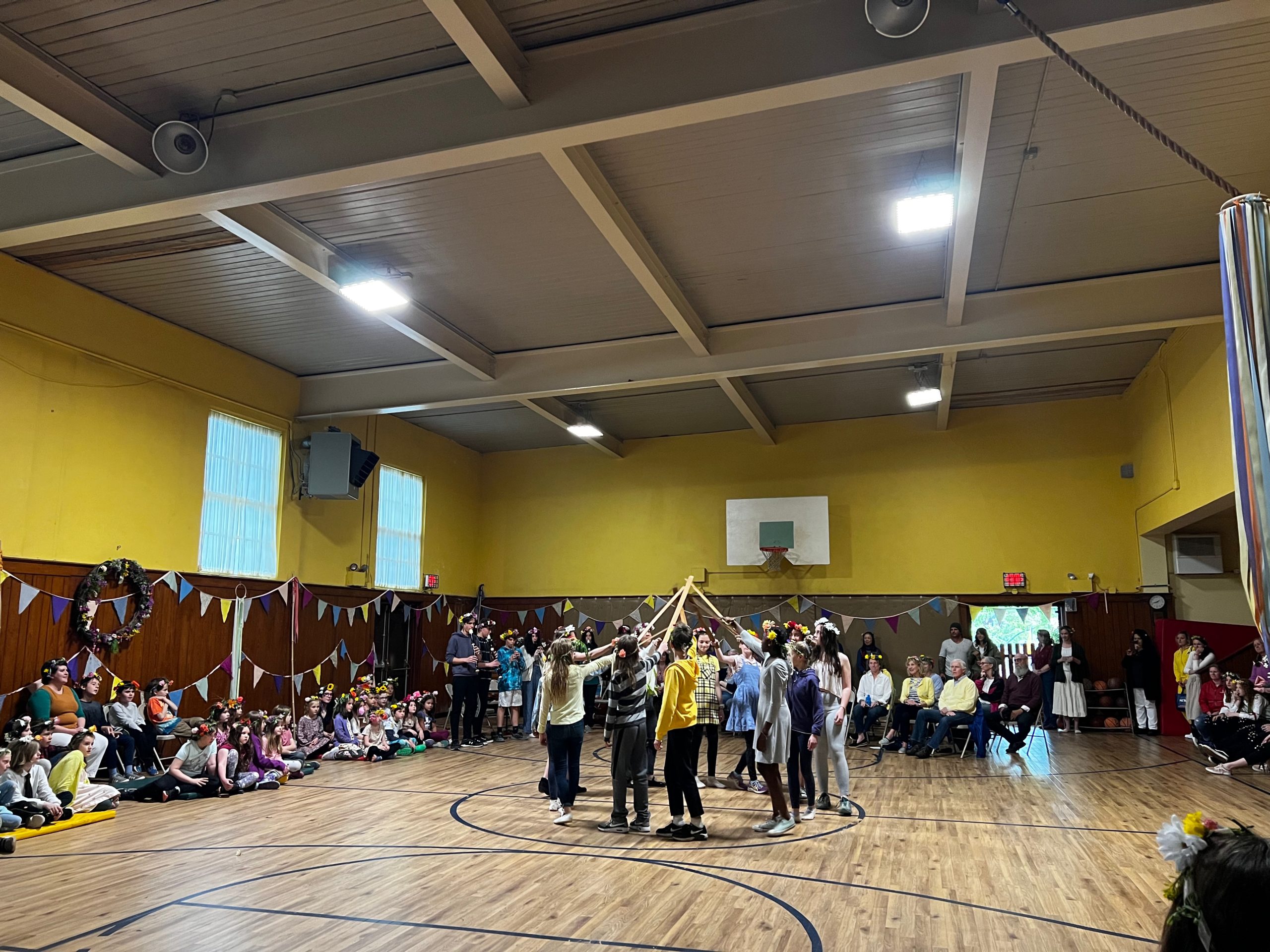

The Maypole songs and dances followed! Our grades students each collected a ribbon as they danced and sang around the Maypole. There was delight, beauty, and laughter in the air. After the completion of each dance, 8th graders joyfully passed out clementines to the students who performed. One could hear the "oohs and ahs" as the Maypole dancers created patterns with the Maypole ribbons. Parents and other community members even joined in at the end!
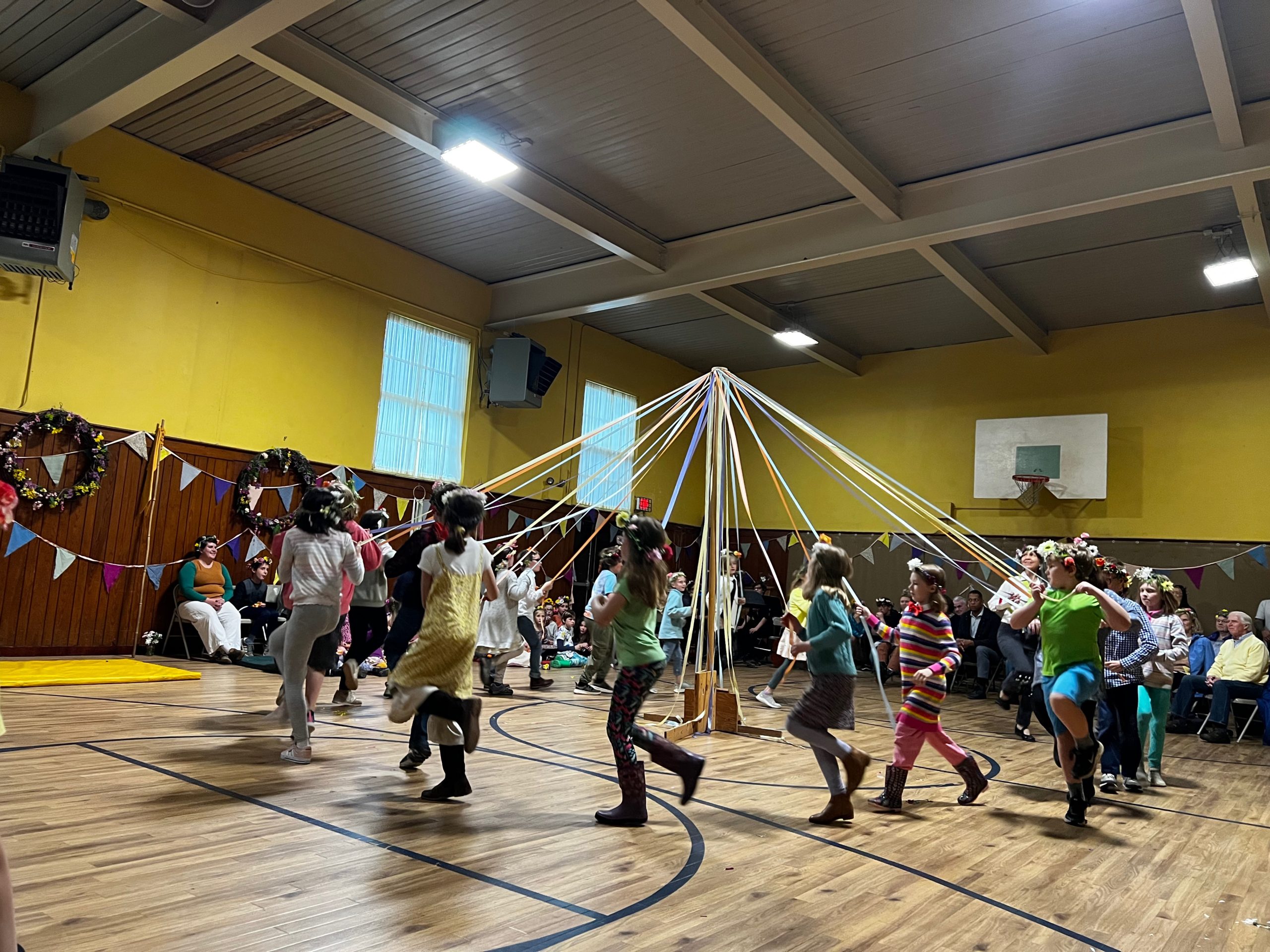
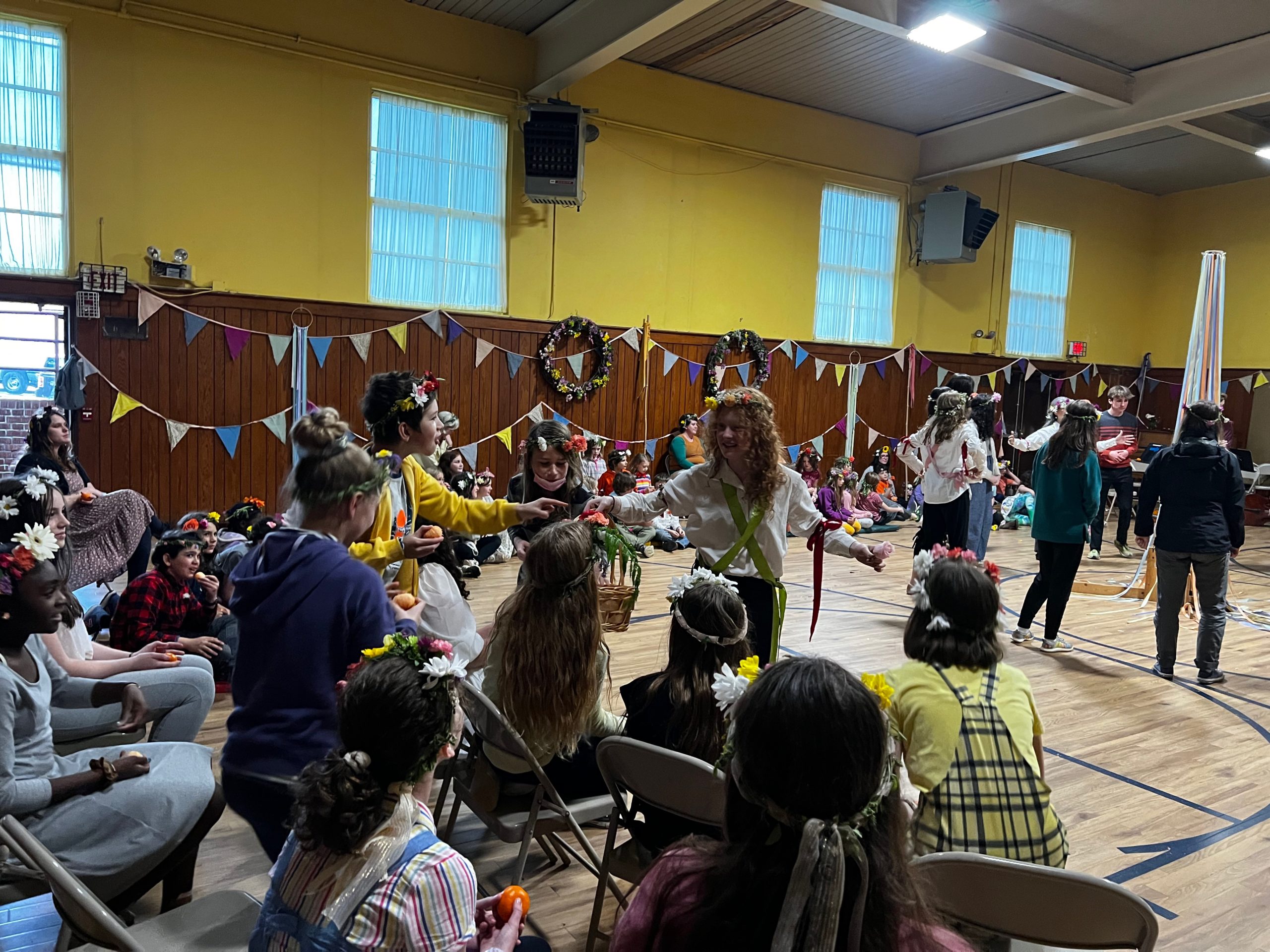

May Day came to an end and the 35th anniversary festivities began! We were so thrilled to come together as a community to celebrate 35 years of Susquehanna Waldorf School. SWS's first teacher, Miss Linda, joined us to talk about the early days of SWS and what she finds so special about our school by the river. We had SWS trivia (congratulations to Magistra Sweeney, Tseng Lao Shi, and Ms Tucker for their perfect score!), a cake walk, an alum vs students tug of war (students won!), and more. It was so good to socialize and share food and games together! We are so blessed to have such a caring and vibrant community.

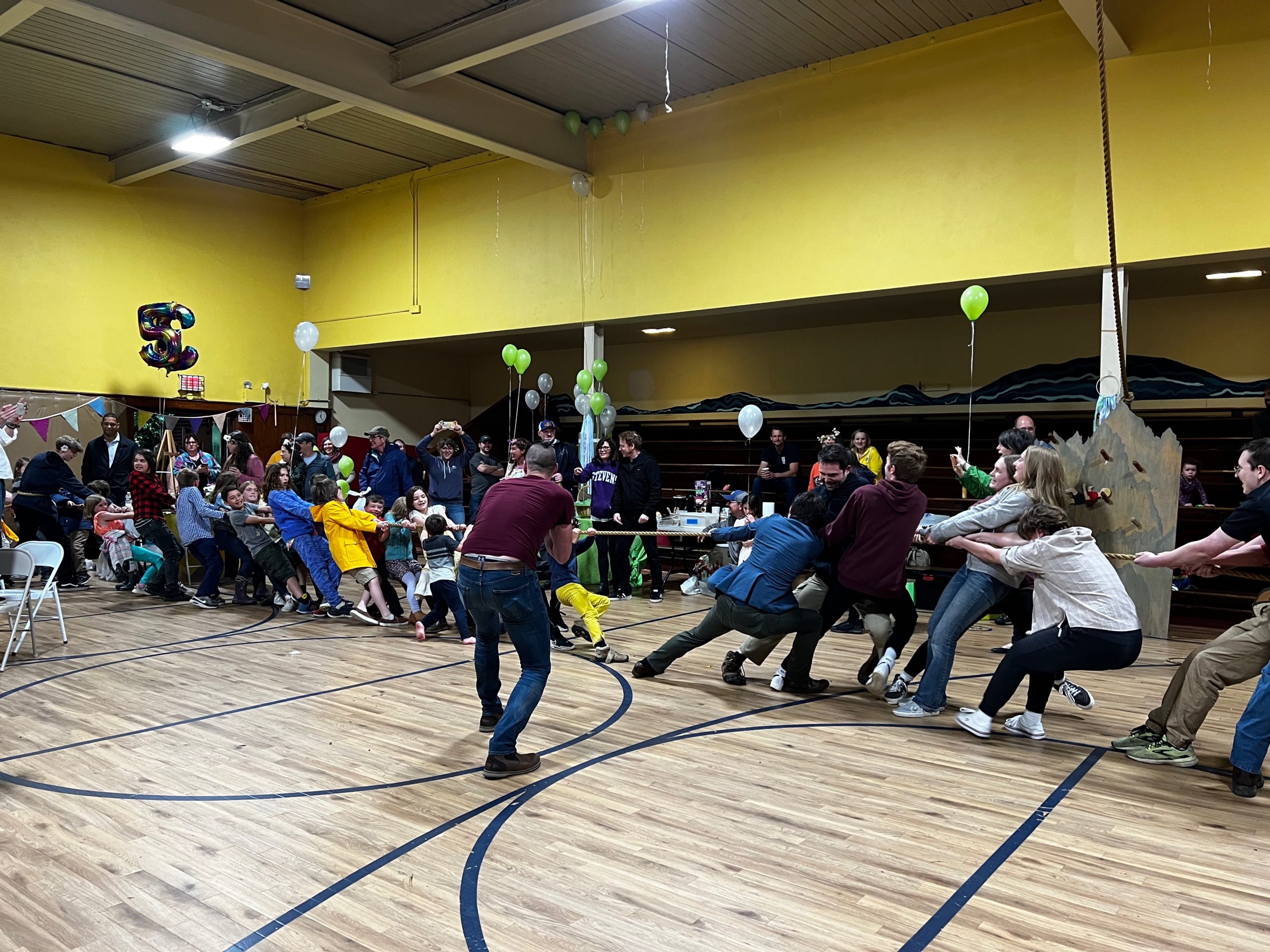
Middle School Mandarin Lessons with Tseng Lao Shi
Written by Mandarin Teacher, Hui-Ling Singer.
As the 2021-2022 school year comes to an end, here are some of the highlights that were captured during Mandarin classes in the Middle school in the month of May.

Miss Katie, one of our Buttercup kindergarten class assistants, came to 6th grade Mandarin class recently as my special guest to share with the children her experience of teaching English in China and Taiwan. She told the children how important it is to learn a foreign language at a very young age and how much fun it was for her to teach English while traveling around Taiwan.
She brought a lot of fun memories from Taiwan to share with the children including a very creative scrapbook and a Taiwan travel guidebook. Listening to her talk about Taiwan brought back a lot of fun memories for me as well. I’m so glad to know that she likes Taiwan so much and would like to go back someday.
Miss Katie is going to Washington State to attend a Waldorf teacher training program and eventually would like to become a certified Waldorf teacher. I told her that maybe after she finishes her Waldorf teacher training and receives her teaching certificate, she can go back to Taiwan and teach in one of the Waldorf schools there. I know that her gifts and talents will be well received in Taiwan. Many joyful blessings to her future endeavors!


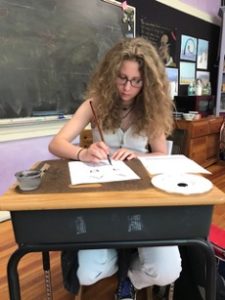
Chinese names have meanings. I’m often asked by my students, “Tseng Lao Shi, what’s my Chinese name?” I always answer, “I don’t know.” They then look at me and say, “Really, you don’t know?” And of course, I would answer “Really, I don’t know.” The reason that I don’t know is because I am hesitant to only use the pronunciations of their English names and match them with the Chinese characters that sound just like their English names. By doing so, there is no meaning at all. My intention is to give them real Chinese names when they are in 8th grade. Their Chinese names will then reflect their personality and strength.

Chinese first names usually consist of two Chinese characters. In Chinese culture, sisters will often share the first character, and the same goes with brothers. Most of our 8th graders have been together for many years, so they are just like siblings. The first character these four sisters share is 怡Yi meaning happy. Here are their names in Chinese with the pronunciation next to each character and followed by the English meaning in the parenthesis from left to right in the above photo: 怡Yi (happy) 柔Rou (soft, gentle), 怡Yi (happy) 敏Min (quick, nimble), 怡Yi (happy) 靜Jing (still, quiet), 怡Yi (happy) 雅Ya (elegant, refined). 8th grade had the opportunity recently to learn how to write their Chinese names in Chinese calligraphy using the traditional Chinese paint bushes.



7th grade loves Chinese dumplings. They had the opportunity to make more in class a week or so ago. I don’t remember my mom following any particular recipes for making dumplings, so I usually just try to remember what they tasted like and experiment along the way. Fortunately, there is more than one Asian market in Lancaster for me to go and get some of the ingredients we needed. I have to say these dumplings turned out quite delicious.
SWS Races Against Racism

Susquehanna Waldorf School joined together and raced against racism this year. Our middle school students gathered every Monday and Wednesday after school to participate in our spring running club to prepare for the annual Lancaster YWCA 5k race. Coaches McIntyre, Sweeney, and Satterlee led the students in running games, breathing exercises, and training for long runs. We're grateful to be just a stone's throw away from the trail that runs alongside the Susquehanna River!
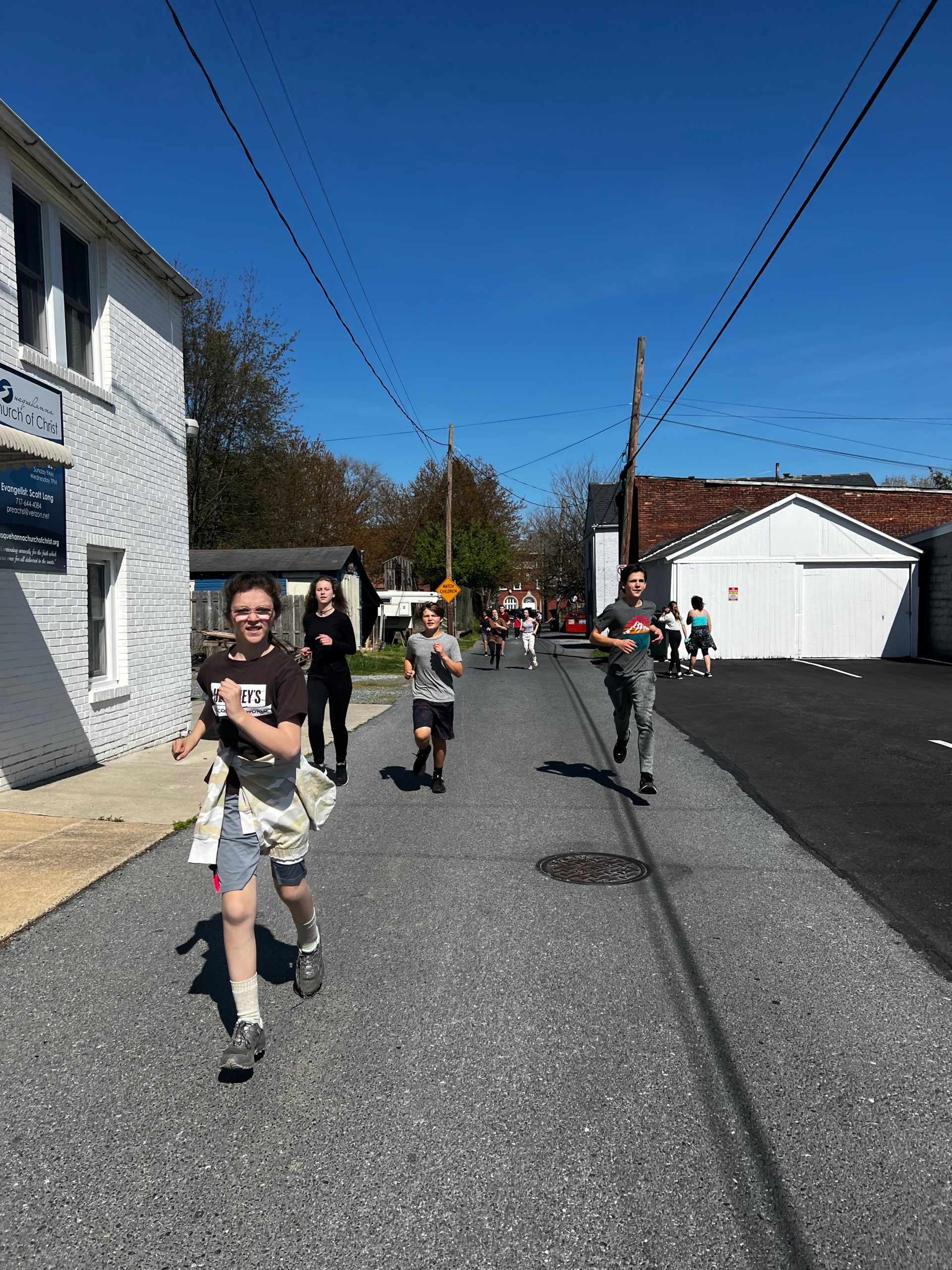


The SWS running club has participated in the Race Against Racism for over a decade but, for the first time ever, we invited our whole community to join. We also were a sponsor of the event this year! The Race Against Racism is not just another 5k. It's an opportunity for community members to come together to stand against racism and support an organization committed to eliminating racism and empowering women. Jasmyne King, the director of Lancaster YWCA's Center for Racial and Gender Equity, visited SWS to share more about the race and the important work the Lancaster YWCA is doing in our community.
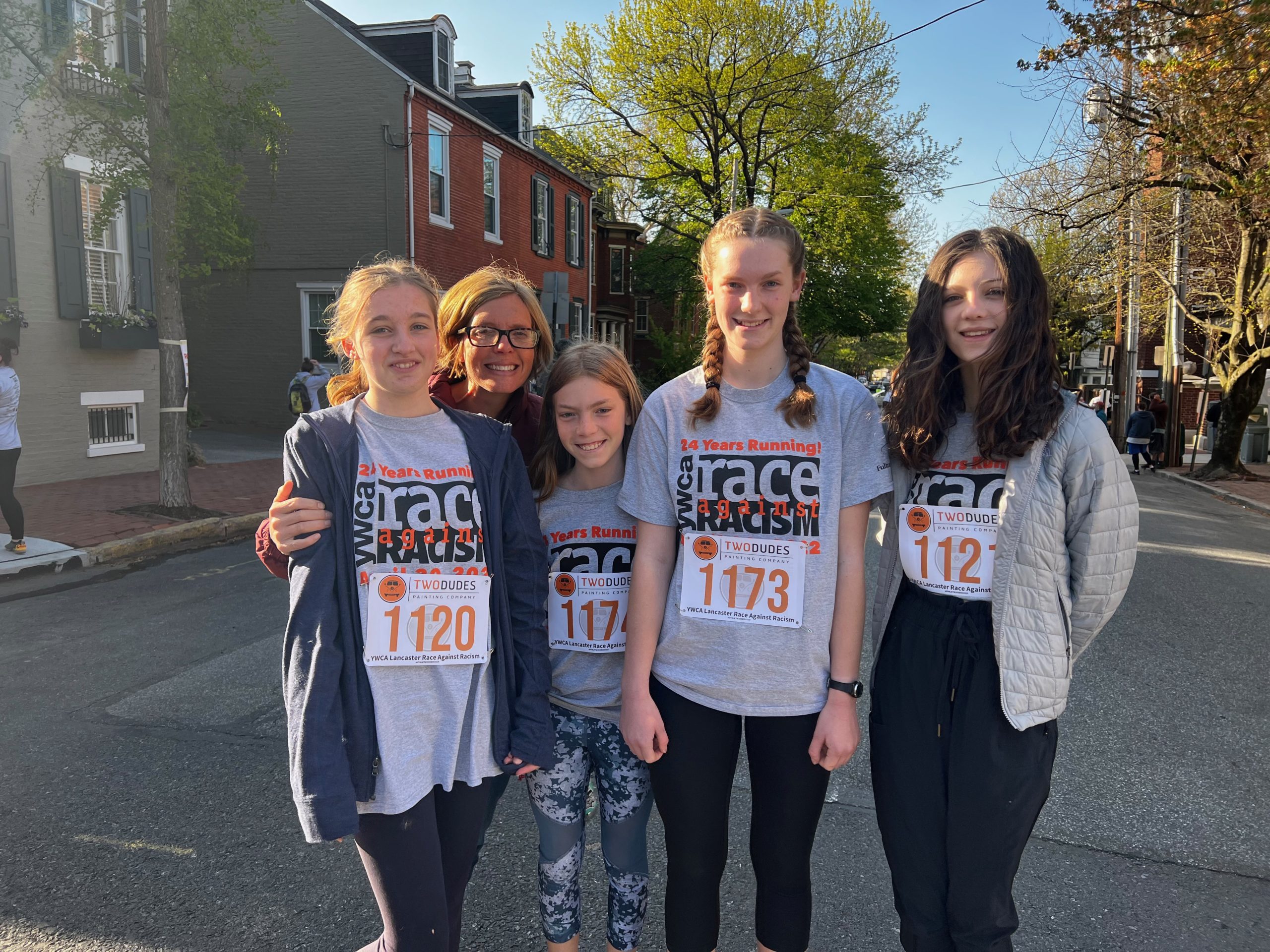
SWS students, faculty, staff, and families gathered together on a beautiful Saturday morning to prepare for the race. It was the first race for some of our students and there was nervous excitement in the air. We stretched together, we laughed, and we pumped each other up as the race approached. Some of us ran the whole race (including two middle school boys who did it in under 24 minutes!). Some of us walked. Some of us did a bit of both. Some of us cheered on from the finish line. We enjoyed live music along the way and the feeling of connection that arises when communities come together for a good cause. We all had so much fun and were thrilled when it was announced that we were the largest school group to participate in the Race Against Racism this year! Congratulations to all who participated. To learn more about the important work the Lancaster YWCA is doing, visit their website https://ywcalancaster.org/.

35th Anniversary Spotlight: Alum + Teacher Nikisha "Nikki" Hill
 We are celebrating 35 years of Susquehanna Waldorf School this year! In honor of our 35th anniversary, we’re interviewing members of our community to share why they love SWS. Alum and Kindergarten teacher, Nikisha "Nikki" Hill, sat down to talk with us about her time at SWS.
We are celebrating 35 years of Susquehanna Waldorf School this year! In honor of our 35th anniversary, we’re interviewing members of our community to share why they love SWS. Alum and Kindergarten teacher, Nikisha "Nikki" Hill, sat down to talk with us about her time at SWS.
On her Early Years at SWS…
I started at SWS before pre-k because my older brother went here and my mom was an assistant to Miss Linda. So she always brought me along. I was exposed to the school from a young age and started pre-k with Miss Linda and was here through 5th grade. The school felt like an entire family. There were at least 5 or 6 families that had children in my class who had siblings in my brother’s class. So when we had birthday parties I would see everyone. Our classes were always together even though we were two years apart.
It was such a tight-knit school. The people I met in Kindergarten are still my best friends. It’s so wild to think that’s how long we’ve known each other and it all started in this building. The community here is so strong.

Favorite Memories…
We had so much fun at the events and festivals. I remember when the gym had a hundred gingerbread houses the parents made and a bag of candy for all the students to have. As a kid I looked at that and thought, “Yes! Bags of candy!” but someone created that. It’s incredible to think about how much the parent body did to make festivals happen.
The Winter Faire was pretty big. It was such a big deal. The pocket lady and all of these fun things. I’d get so giddy as a kid about it. May Faire was a big one too. I glorified that day as a kid. It was so magical and fun. Making wreaths and having flowers everywhere. I remember that my desk was full of flowers and I picked whatever I could to put in my crown. “I got a rose! I got a tulip!” It was so magical to build this special crown that I got to wear all day.
I think, too, of the relationship I have with Waldorf education. I went to public school for my middle school years and I was really excited for a bigger, more diverse setting but I was disappointed and surprised by some of the things I ran into. I remember going to my art class and they were putting stickers on a stock card. The teacher told us to make a scene with the stickers and I was like, “What? This is art class?” Students weren’t able to sing in harmony together and I was like, “we did that in Kindergarten!” There is a depth and quality in Waldorf education. It was interesting to compare Waldorf education to public school in my young brain.

How her View of Waldorf and SWS has Changed Since Becoming a Teacher…
I’m just blown away by the commitment here. The academic rigor and intentions of why we do things are amazing but it’s the extras, the small little details, the intentions of putting feeling and love into all that we do that makes me think, “Oh my goodness, that is so big and so magical.” That takes time. It blows my mind to think of all the things that were catered to me as a child and recognizing that, as an adult, those things were given to me by adults. All that love, care, and little extra moments were given to me. That’s what inspires me as a teacher. To know those tiny gestures make all the difference. The reverence that goes into what we do here is so incredible.
I think it’s beautiful that I’m still in touch with my kindergarten teacher, that my brother is still in touch with his kindergarten teacher. It’s amazing to think, “oh my goodness, they have seen us evolve, and change, and grow.” I think it’s rare in the world we live in now. There’s not a lot of time to foster those relationships or the reverence of noticing, or finding the simple but we do it here.
Skills Learned From Waldorf education…
I think about why Waldorf education speaks to me and a lot of it is the life skills I was taught. It wasn’t a question of “did I just do it to get it done?” but rather “did I understand it? Did I question it? Did I put love and my effort into something? Did I do it well?” That starts in Kindergarten. How we feel, how we sing. Are we using our beautiful voices? Are we noticing the tiny snowdrops coming up? All of the tiny gestures are life lessons. It’s not just to learn about plants or to sing at a certain octave level. It’s this life skill that carries us through what is purposeful and what is meaningful to us for the rest of our lives. That’s the awe I have in Waldorf education that I’ve now recognized as an adult was given to me as a child. It’s the simple things that carry us.
It’s funny because if you were to talk to my teenage self, there is no way I would be back here in Waldorf education. “I will never wear wool socks, I will never wear linen. I won’t do it. You can’t make me. I won’t knit socks, I just won’t do it.” It’s funny how things come full circle. As I’ve matured, I’ve realized the deeper purposeful and meaningful life skills I was exposed to at such a young age that I just took for granted as a kid.
I studied special education in college and just felt like there has to be more, there has to be more than just this very standard, very superficial do’s and don'ts of education. There was no questioning, there was no deeper understanding of why those are the things and why we do those things, or any of the whys. So I had all of these questions which then led me back to Waldorf education, curative education and social therapy. I felt like those questions were being answered in a broader lens. I learned to go deep into the individual and the diagnostic while also asking why and expanding on that. I think Waldorf education, just if I look at what I’m doing in Kindergarten, is allowing the child to have an imagination. Later in life that child learns to ask why. That’s something that’s incredible. If we allow our children to play with the impossible and the imagination, that gives so much more opportunity later in life to go deeper.
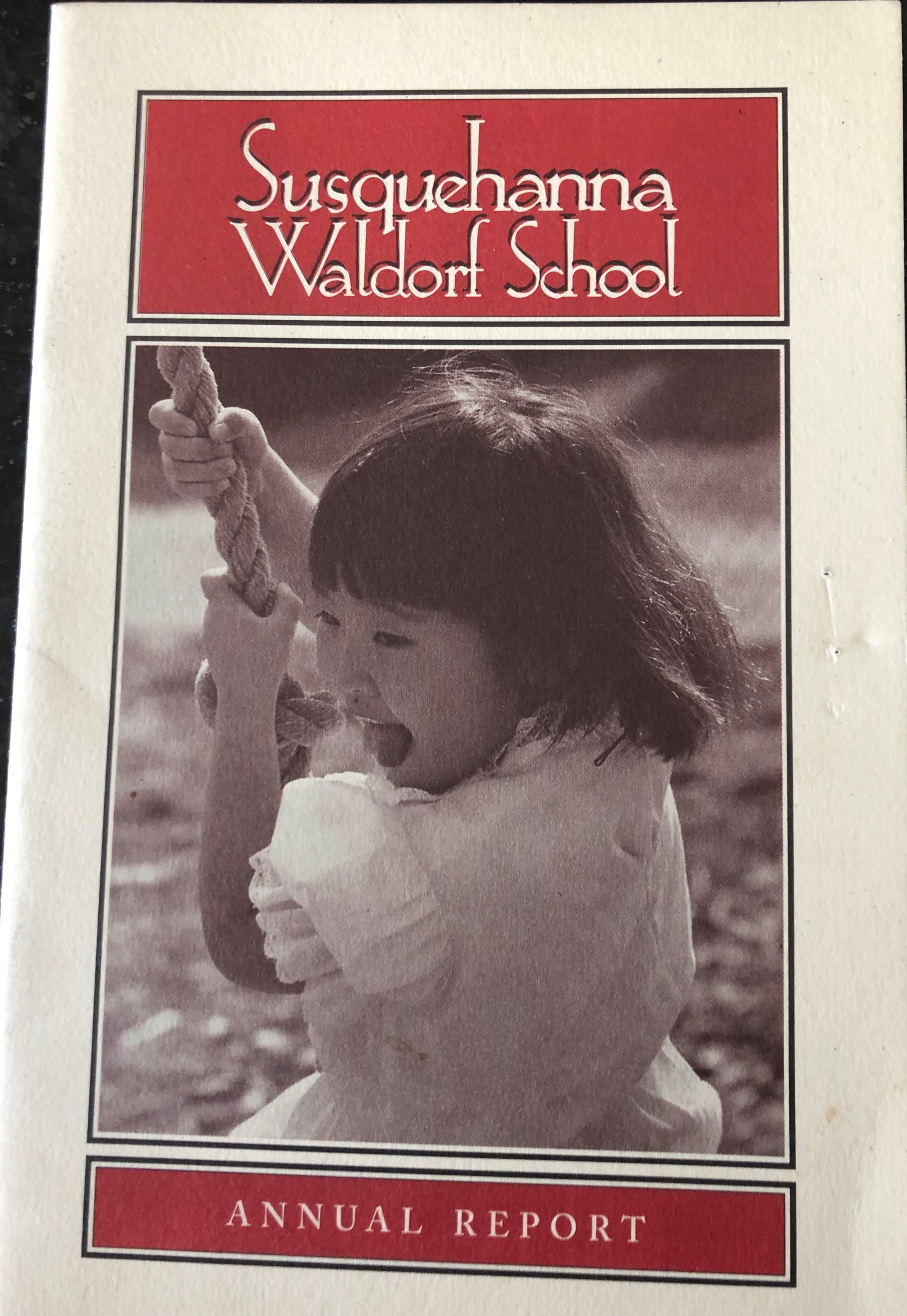
What Makes Susquehanna Waldorf School Special?
SWS is a small school with a huge heart. We’re a little school in the middle of a valley, hidden by the river, but it’s a powerful place. When you walk in, it’s alive and there is so much warmth here. It’s blossoming, it’s growing and pulsing with people who genuinely care. They care about everything. It’s not, “did you learn this today?” checkmark, it’s “who are you and how do I get to meet you as a person? How do I get to support you as a person?” That goes for colleagues, for students, for families. It’s just incredible how much care and love is dedicated in and out of this school. It’s tangible. You walk into this school and it feels different. It might be a diamond in the rough, it might be small but it’s so full.
Spring Adventures & Learning with Class 4/5
Written by Class 4/5 teacher, Brooke Corridoni.

To enrich the curriculum many things happen outside of the classroom. Class 4/5 has taken full advantage of the beautiful spring weather by going into the field for botany and animal studies. Our class went on a botany bike ride to explore Marietta's amazing bike trail while looking out for the signs of spring. We noticed many plants in bloom while riding our bikes and stopped to journal some of these finds. We also saw the wildlife waking up all around us. The Northwest River Trail is an amazing perk of the location of our wonderful school.

Our fourth grade class is in our block of Human Being and Animal Studies. For this deep exploration of different species we took a class trip to the Wolf Sanctuary of PA where we went on a guided tour through the grounds. We learned so much about wolves and the stories of each wolf that calls this sanctuary home. The students were in awe as, not long into our experience, all the wolves started howling in unison all around us. It was such a magical experience walking so close to these creatures.

On Earth day the whole school was lucky to have Raven Ridge Wildlife Rehabilitation Center come and give a presentation. Class 4 had reached out to the organization to further enrich our animal studies block and the wonderful idea to bring it to the whole school for Earth day was offered and sponsored by a sixth grade parent who volunteers at the center. Tracie, the founder of Raven Ridge, brought many animals to the school to show to the students, those included two Box turtles, Black Rat snake, skunk, Opossum, Red-tailed Hawk, and the Black vulture. She told us so much about each animal and their individual stories on why they now live at the center.

We are also growing Oyster Mushrooms in the classroom! We will cook them up and add them to a pizza very soon!
Times Tables with Class 2
Written by class 2 teacher, Mandela Davis.
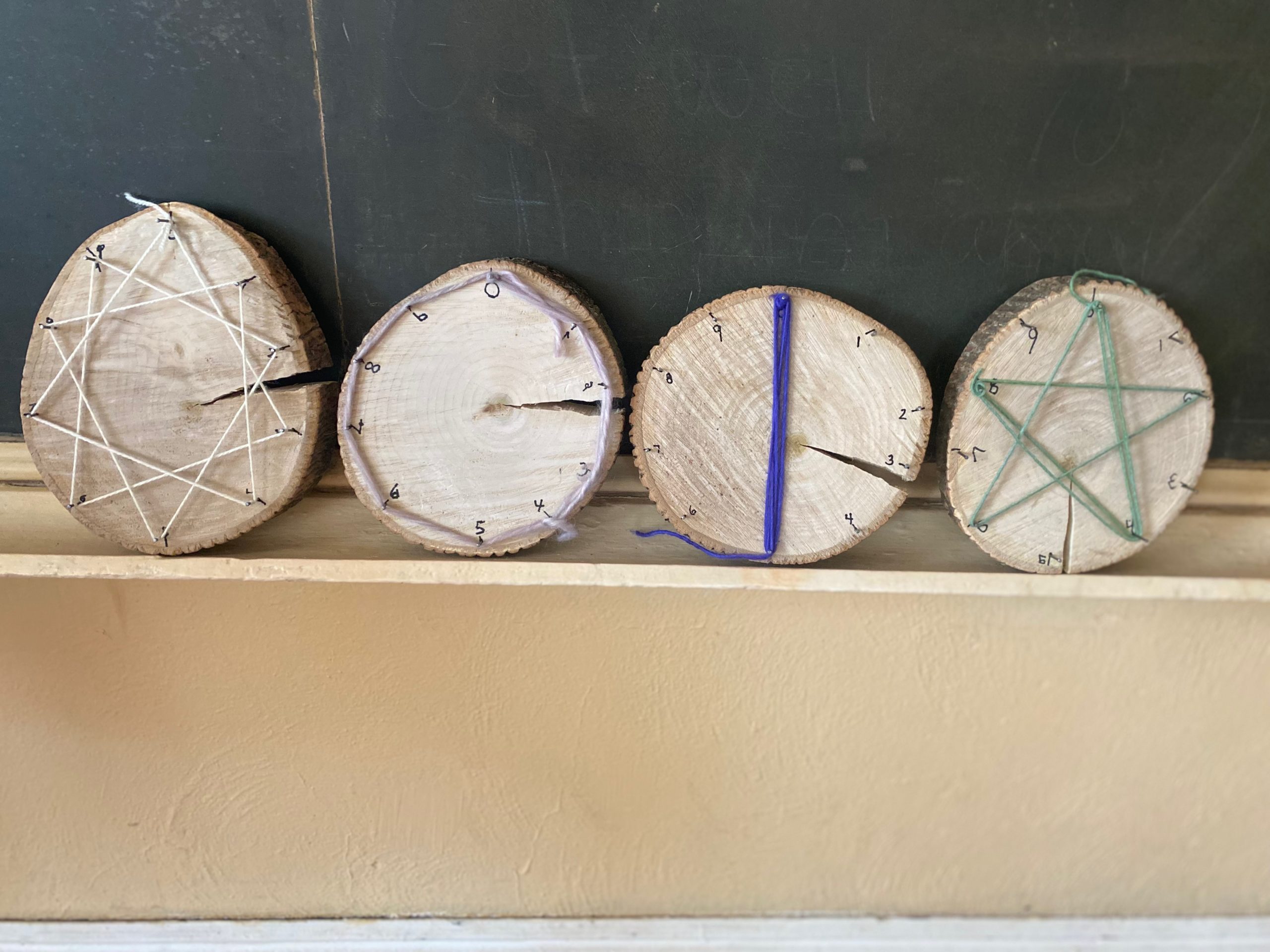
Here at Susquehanna Waldorf School, and many Waldorf schools around the world, we believe that learning should be fun, creative, and inspiring. Second grade is a very exciting year when it comes to math. In the fall, students review what they learned in first grade and build from there. Second grade students dive deeper into learning all about multiplication and learning the times tables.



The times tables are taught through songs, movement, and imagery. One unique way of teaching this is through the magical times table circle. The teacher draws a circle on the chalkboard, writes the number 0 on the top of the circle and 5 at the bottom, and the fills in the numbers 1 through 9 in a clockwise direction. The teacher then starts at 0 and connects a line to numbers 2, 4, 6, 8 and then back to 0 to represent the number 10. Children and teacher look at the shape of a house in the circle, which emerges from the two times tables. Not only are the children seeing the pattern of numbers, they are also seeing the shape this particular times table creates. The teacher goes through each times table number doing this.
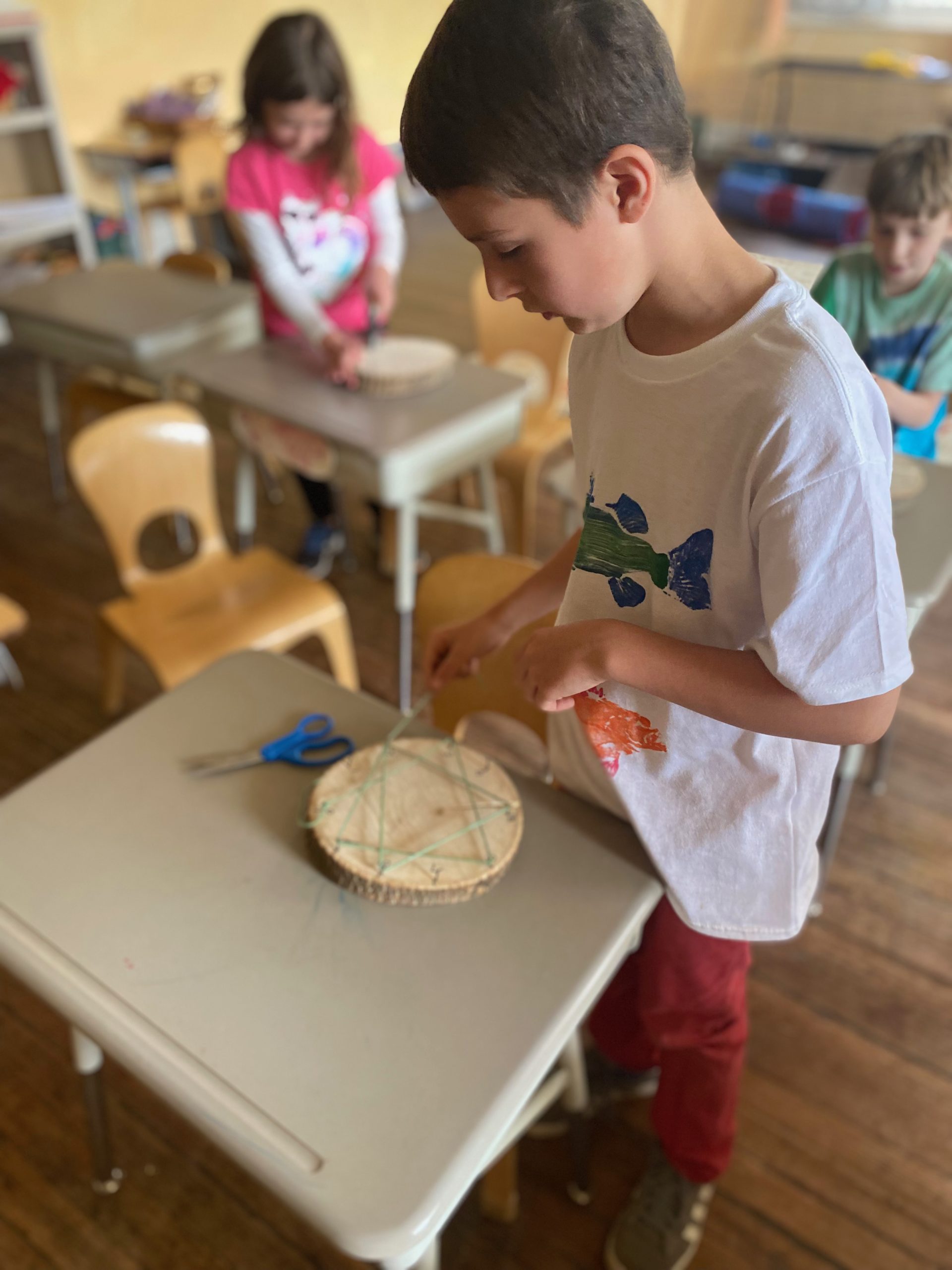


After teaching the students the magical times table circles, the children made their own wooden times table circles this spring. Each student got a round piece of wood, sand paper, 10 nails, hammer and a variety of colors of string that represented different times tables. The children worked on this project in math skill lessons in the month of April. Each child then got to take them home. My hope is that through song, stories, and the magical times table circle project, students will find a deeper meaning and understanding of multiplication. A deeper understanding and love that will carry them on to the older grades and higher math levels.
35th Anniversary Spotlight: SWS's First Teacher

We are celebrating 35 years of Susquehanna Waldorf School this year! In honor of our 35th anniversary, we're interviewing members of our community to share why they love SWS. We're kicking off this series with SWS's first teacher, Miss Linda.
On how she became the first teacher…
I was here for 31 years as the kindergarten, parent/child and nursery teacher. I was the first teacher and it happened by accident. Another woman who was trained in Waldorf education backed out in August and, because I had a degree in early childhood education and I was going to assist her, all eyes turned to me. “You’re doing it, right?” Gulp, okay. Dorothea and Hal Williams were my mentors. He was an anthroposophical doctor based in Lancaster and Dorothea was a handwork teacher. Williams Hall and Dorothea’s Garden are named after them.
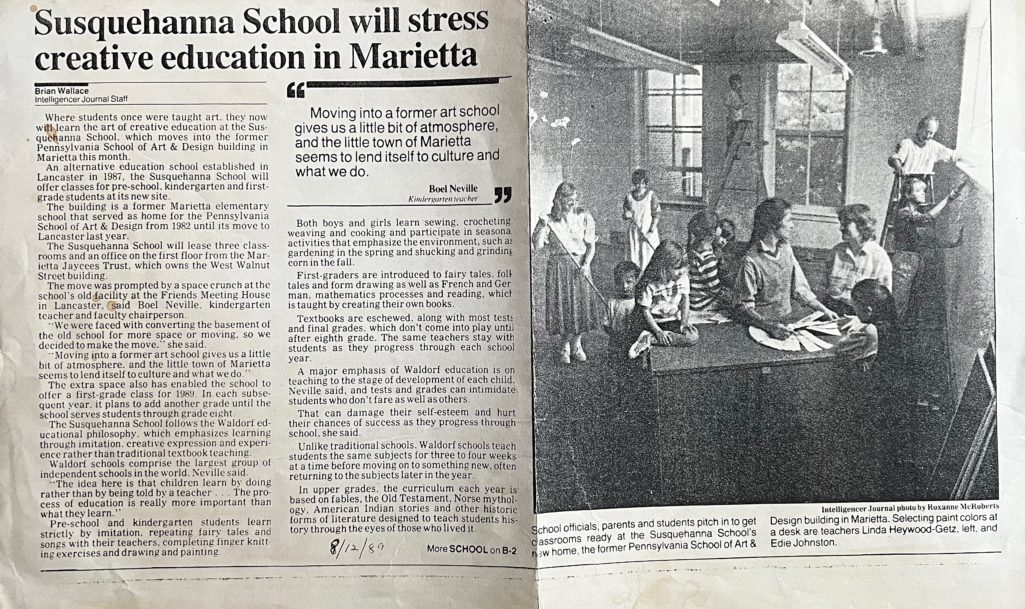
What were the early days at the school like?
We started at the Friends Meeting house in Lancaster. It was so kind of them to offer their space. I didn’t know much about Waldorf education at the time except that it hit me right in my heart. I knew I wanted it for my children. It was a very loving, heart-centered community.
Two years later, we had outgrown what they could do for us, we needed more space, and we moved to our current location. Coming here was a leap of faith. We kept growing. We gradually took room after room after room and ended up buying the building. We all pitched in and painted rooms. People made tables (we had a lot of woodworkers as part of our community). Some of the tables are still actually here. I always told the children, "I want the old tables. They have the stories." The stories are in the tables. That’s the history of the school right there.
We’re in an old building. In Waldorf education we talk about the being of the school and it felt like the being of the school shook hands with the building and agreed to do this. We had our ups and downs over the years but the school has always been such a light in the community.

On the Susquehanna River…
The river called us to this place. As a kindergarten teacher the river was a place to go that had heaven and earth right there. All the elements were there: earth, water, sky. The children loved it. We would explore. This was before the rail trail was there and it was totally wild. We would bring bags and pick up junk. There’s such a calling to the river. It’s hard to put into words.
The river’s big. It’s moving. It’s alive. The Susquehanna River is the very picture of life passing: it’s full of possibilities, it catches the light. It really is a metaphor for what a school could be. A lot of it is in your way of imagining what the school was and what it could be.
I think that as the years went by and the rail trail was established, more of a relationship for the children developed. A lot of times it was in the teachers' or administrators' minds. But once all the classes found it as a place to go and relate to, it grew out of that. At the end of my teaching, we’d go down to the river every day. We’d say good morning to the river. “Good morning river!” We’d stand at the banks and salute the river. “Thank you river, goodbye river!” It’s hard to imagine the school anywhere else, to me.

Favorite Memories…
I’ll cry. What I love so much about the school is the rhythm of the year. I can’t even say there’s one May Day that stands out. It was this collective sense of May is coming. We got a Maypole, we learned May Day songs, we made wreaths and we brought flowers. All of the festivals really spoke to what we were about and the beauty of being alive. The Advent Garden/Spiral. So many recollections of that, telling the story, sitting in the center, getting the greens. It was all so coherent. From my point of view as an early childhood teacher, the children sensed a coherency of the year and of being alive; to living and working to make the place beautiful and reflecting the fact that the world is good.
I’ve met so many amazing people in these walls. Collectively there are so many amazing people that have come here. Because it’s different, because it’s alternative, people who came to check out the school were conductors, filmmakers, national level hockey players, the whole gamut of individuals who were curious about us. Those who found a home here brought all those talents as well. The community creates the school and as a teacher, the number one thing I’m trying to teach the children is community and how we work together.
Another memory I have is that a partner of mine died of brain cancer while I was here and that tree (points out window) was planted right there in his honor and it was just a little tree at the time. When I come here, the memories of my life are here. Dorothea’s garden at the back of the school used to be paved. There was a straight cement path of sidewalk and a chain link fence. We thought, “how can we change this?” We jackhammered it up. The playground was a parking lot when we got here. There was nothing, just a big parking lot.
I’ve watched things emerge here. Children emerging into who they are is the same as watching the school emerge. The school became more and more what it is through those of us who saw what it could be.
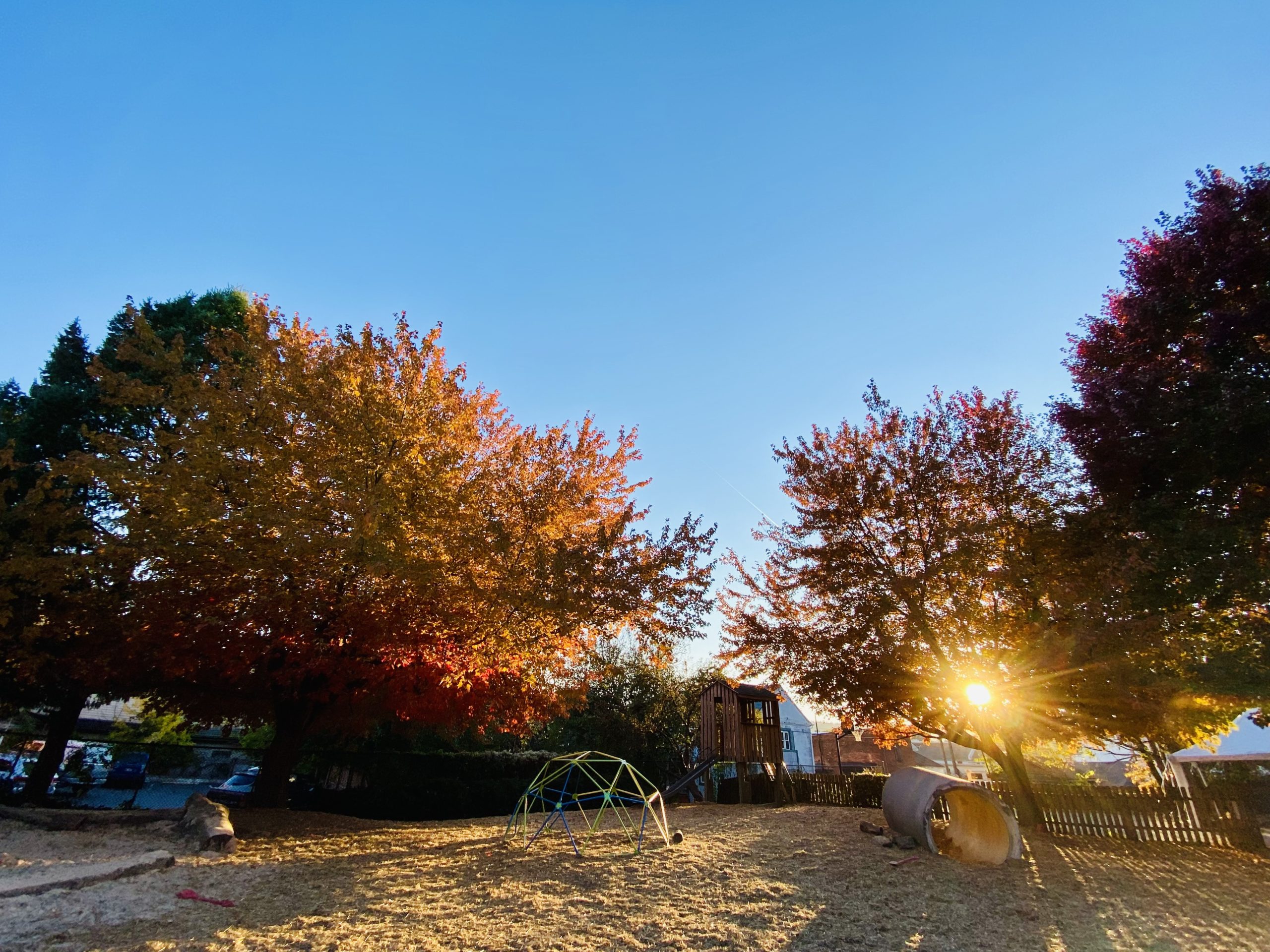
Final Thoughts…
Working here has been the greatest gift. People have worked so hard for an idealistic sense of how we can better be with one another. We had all of these different rules over the years, how to communicate with each other, we explored conflict resolution. There’s so much earnest striving. There’s a verse by Steiner, earnest heartfelt striving. That was here all of the time and I think in all Waldorf schools. That’s at the heart of it. Striving for something better for the world via the children and what they can do.
What’s happened here has already changed the world. It happened from the very beginning, it made a difference. There’s so much love here. The teachers for their kids. There’s so much love here. And love is what changes everything. You need to be sharp-sighted and intelligent and set boundaries and love and commit fearlessly.
I’m so appreciative. I couldn’t ask a better way to spend 30 years of my life. I can’t imagine it any better than the way it’s been here. I feel so grateful. I walked away with a greatly expanded heart. And it has nothing to do with me, it’s the community.
6th Grade Physics
Written by 6th grade teacher, Rochelle Dietz.
In 6th Grade, Physics is brought/taught through observation (observing phenomena) and hands-on experiences/experiments. Just as we've approached all of our learning, the goal is to cultivate an attitude of awe, so that they may truly see and experience the marvels around us. This is not done through what some Waldorf educators call "edu-tainment", but through observing phenomena (a phenomenological approach). Over the course of a 4-week block of study, 6th graders explored the sources of Sound, Light, Heat, Magnetism and Electricity.
With the exploration of sound, we learned about the larynx. According to Rudolf Steiner you can “bring acoustics into relation with musical science when you describe the human larynx physically and physiologically” (as cited in Trostli, 2016) After this description, we compared human sounds with other types of sounds. We explored how sounds are created , pitch and volume and how sound travels.

This exploration of sound ended with a very exciting demonstration, sort of a mystery called the Chladni plate, where the students could “see” the effects of sound that are made visible through the changing geometric forms engendered by sounds.

The study of light was up next and we started with the experience of complete darkness, which happened on our stage. With all the curtains closed around us and every patch where light could possibly enter covered with cloth, the students sat in a circle and the lights were turned off. Once they sat in this darkness for some time, a small candle was lit and the flame observed and experienced. A reflection on their experience came later through beautiful poetry and illustrations.
 (Poem by Bija Nicarry, age 12, shared with permission)
(Poem by Bija Nicarry, age 12, shared with permission)
An exploration of light and darkness followed and much of our time was dedicated to the experience and study of color, which included the generation of color, afterimages and colored shadows.
Exploring the colors of light was definitely illuminating as they discovered the primary colors of light are different!

The study of heat was next and we focused on the warmth of colors, of sounds and of materials. We also explored how heat originates through combustion, light, friction, internal stress and electricity. Concluding our time with how heat travels through conduction, convection and radiation.

Up next was the story of the discovery of magnetism, which took us back to Ancient Greece and a shepherd named, Magnus. Magnus tried to sturdy his walk by placing nails into his shoes and his staff and found himself a high rock from which he could watch his sheep. Little did he know that he was standing on a “magical” rock. He could hardly move when he tried. From our studies in Geology, the students knew that this rock was indeed magnetite and that Magnus had discovered magnetism.
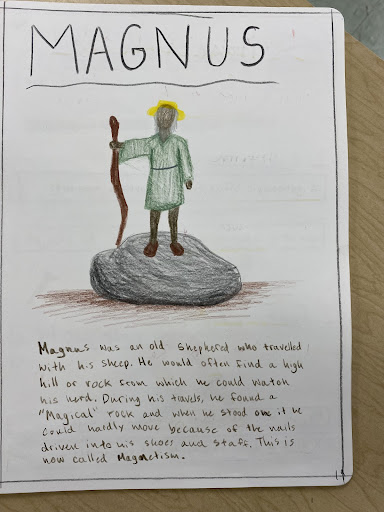
The students explored magnetism through various stations where they could discover the attractive power of magnets, how magnetic poles attract each other, that magnetism can travel through many materials and how a field of force penetrates and surrounds a magnet.
We concluded our introduction to 6th grade Physics with the study of static electricity. Here again we started with a story, that of a Greek scientist named Thales. He noticed that when amber was rubbed with a wool cloth, light objects were attracted to it. Electricity is named for the Greek word for amber, which is electron. The students enjoyed exploring how static electricity is produced by rubbing certain substances with other substances, that a static electric charge has the power to attract or repulse, similar to magnets and that static electricity can be detected and stored.

Our culminating demonstration was creating a Leyden Jar, where each of the 6th graders got to experience how a small charge would jump to the nail in the Leyden jar and then how a shock could be felt from the stored electricity!
Last but not least, we visited the Lancaster Science Factory to bring it all together.

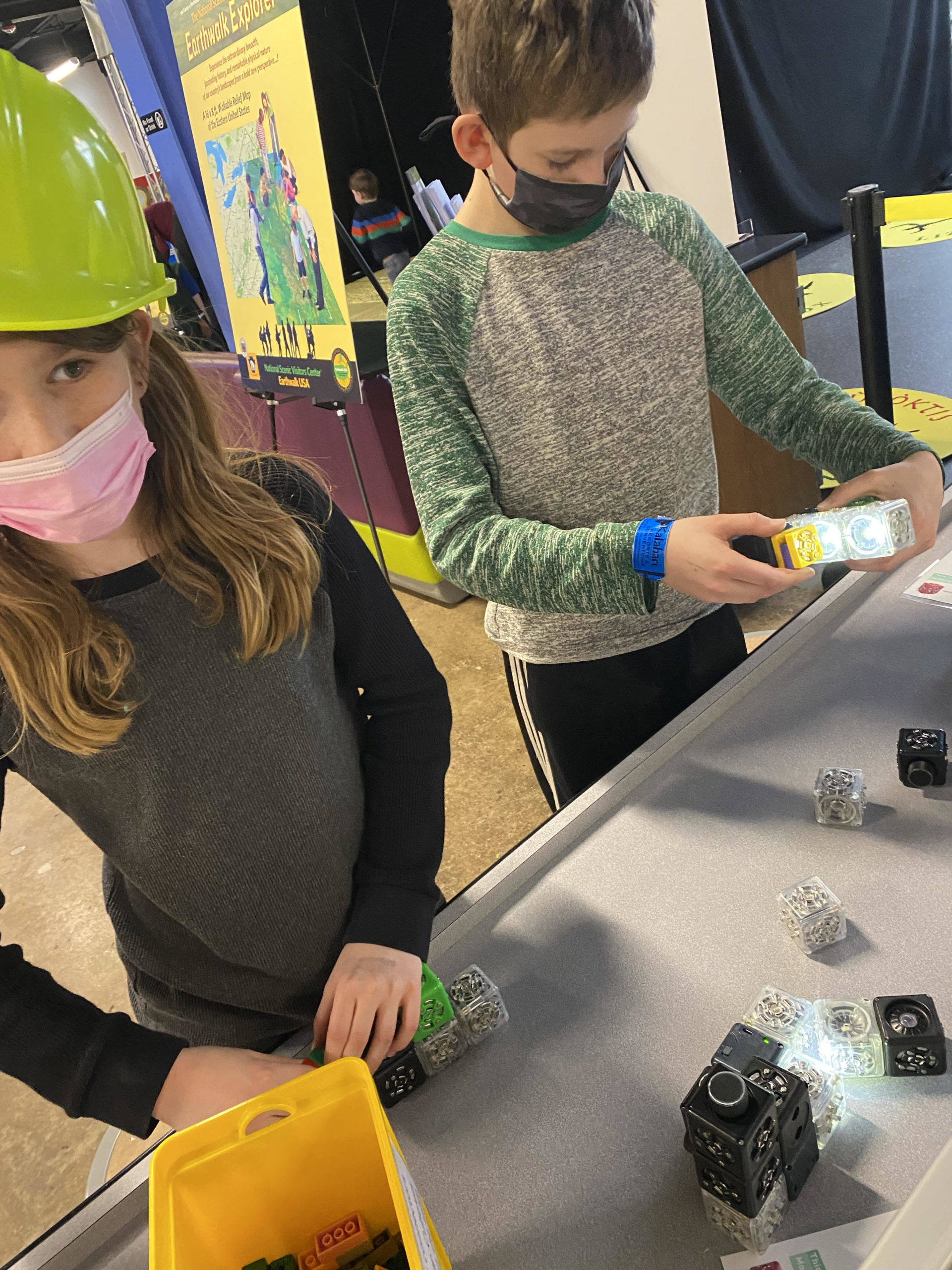

Trostli, R., & Trostli, R. (2016). Physics the Waldorf way, grades 6-8: A Manual for Teachers. Lystra Books & Literary Services.
Anna Perenna: A New Year’s Celebration in Ancient Rome
Written by Latin teacher, Magistra Sweeney
At SWS our Classical Latin classes learn grammar, vocabulary and pronunciation, but also live the language through the celebration of some aspects of the ancient Roman festivals. Roman history and culture come to life during recognition of Fontanalia in October, Saturnalia in December, and, most recently, Anna Perenna, the early Roman New Year’s celebration, in March.

The origin stories of Anna Perenna are many, but we follow this version. In 494 BCE, the plebeians, tired of paying taxes and being conscripted into the army with no say in the government, left Rome and secluded themselves on the Sacred Mountain. An elderly woman, Anna, kept them alive with cake for some time, until they were coaxed back to Rome with a promise of better representation. After Anna’s death, she was declared a goddess and called Anna Perenna which can be translated as “lasting throughout the year.” Her outdoor festival, which included tenting, feasting, games, dancing and singing, was held on the 15th of March when the moon was full and spring was just beginning. March was the first month of the year in the old Roman calendar, before the Julian calendar was established in 46 BCE. The god Mars represented the new year and Anna Perenna the past year.
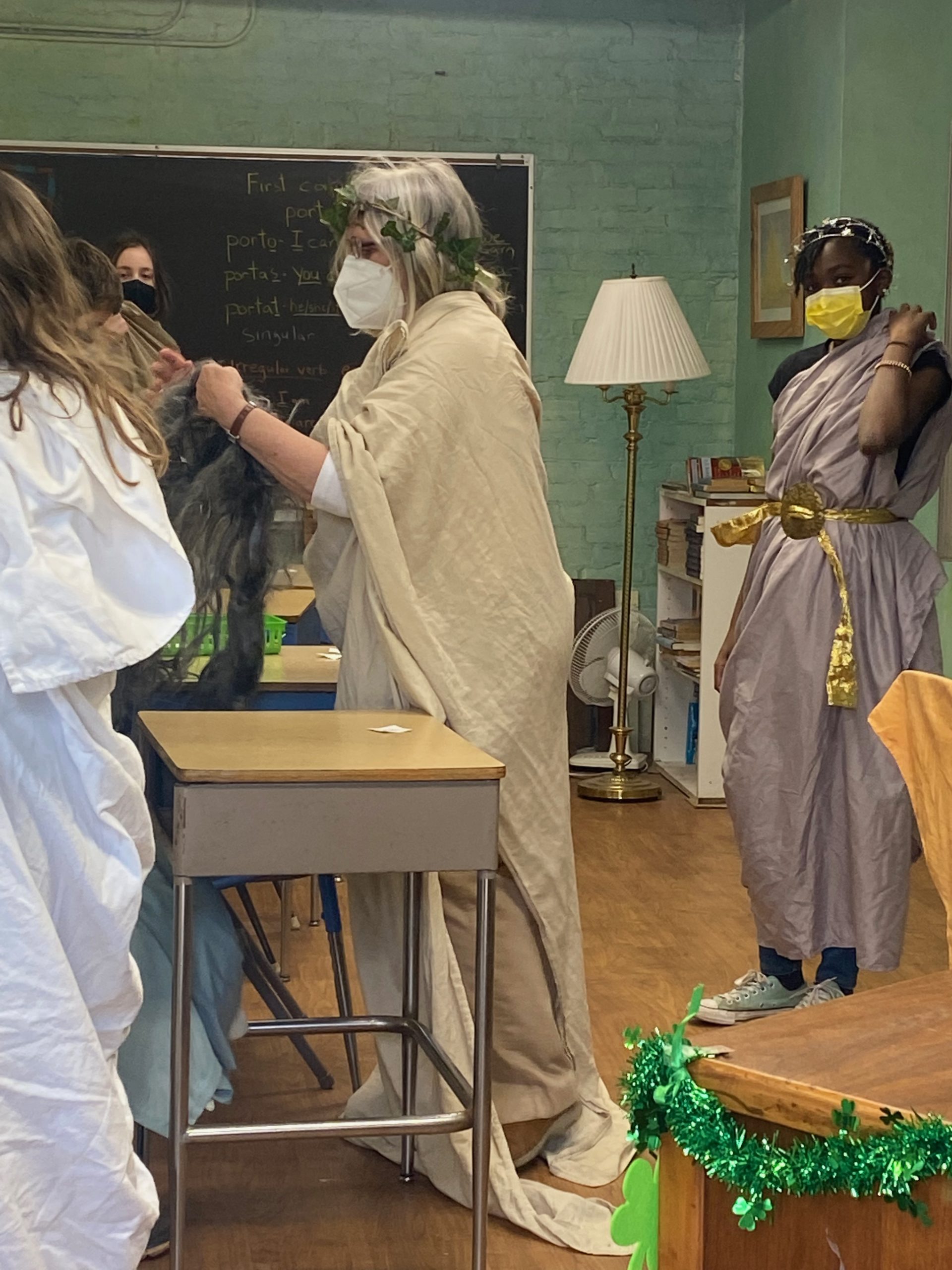


To celebrate Anna Perenna, our Latin classes are transported to ancient Rome.The students in grades 5-8 laugh as they struggle to wrap themselves in togas. The fates choose one class member to portray the old woman, Anna, and another to portray the god, Mars. In procession with chimes ringing, we walk with some pomp and circumstance to the outdoor tent where a table is laid with a great platter of cake slices, honeyed cheese and a fish-shaped pitcher of grape juice. We toast the old year, Anna Perenna, and then the new year, Mars, with “felicem novum annum” (Happy New Year), socialize and enjoy our cake together. Then it is time for games. This year we played “abde et pete” (hide and seek) where the seeker counted from “unus to viginti” (1-20) and shouted “paratus aut non, hic venio!”(Ready or not, here I come!). Festivals create joyful memories and enliven the students' perception of the ancient people who spoke the language they are striving to learn and translate.
A Gratitude Note from Dr. Tom
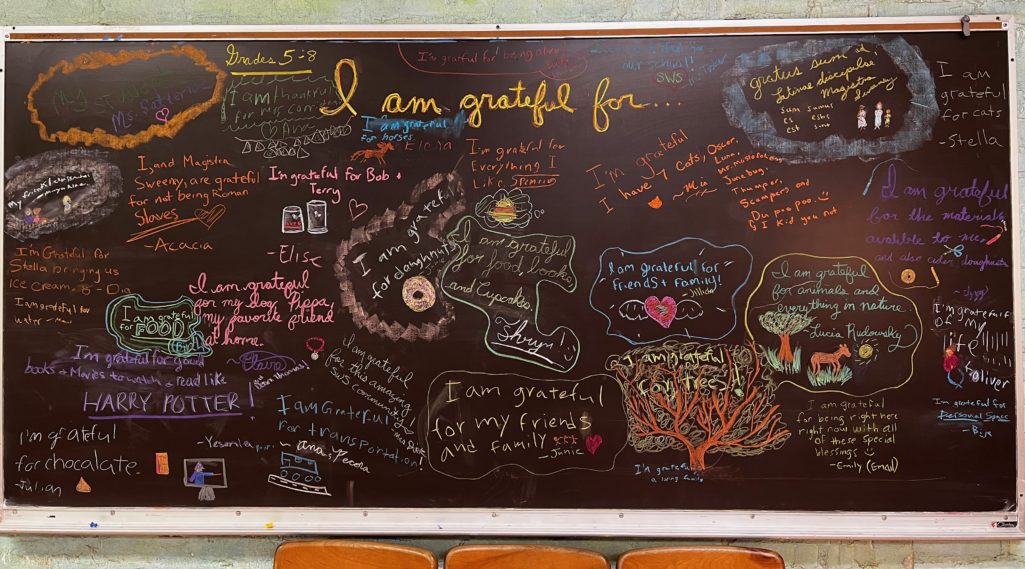
As we enter this season of gratitude, I'm reminded of a poem written by a Waldorf teacher that begins with the two lines...
Home is where the heart is
So let this heart beat strong.
For the children in our care, home and school is the heart of their world. The support of our parents and the hard work of our teachers create a nurturing culture that we are grateful for at this time of Thanksgiving.
For our students, the heartbeat of the day starts with a greeting from a teacher, a rhythmical verse with classmates, and a measured song of reflective meaning. The challenge of the main lesson transcends memorization and recall to focus on the essence of learning: reflection, debate, understanding, and application. When I observe our dedicated teachers at work, I am thankful for their energy and talent to create authentic learning materials that challenge critical thinking and nurture self-discovery.
Susquehanna Waldorf's teachers are aware of society's influences on young people that can lead them to feel entitled to many things we can take for granted. Each teacher accepts the challenge by modeling reflective behavior and designing lessons that build awareness for all we have. How exciting to think about the impact of our grateful and resilient students will have on our future world! To borrow from the principles of Waldorf schools...
As an individual in society, our students are empowered to serve humanity with the strength of will, depth of feeling, clarity of thought, and the ability to work with others.
Thank you again for all your support of SWS. Have a warm and reflecting Thanksgiving!
Tom

